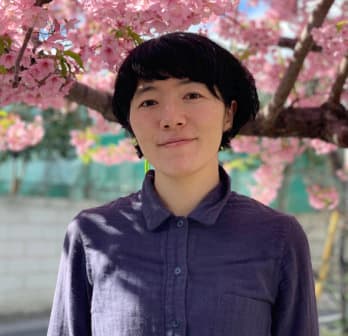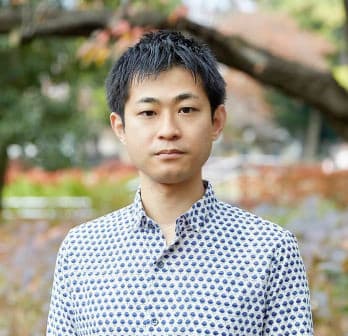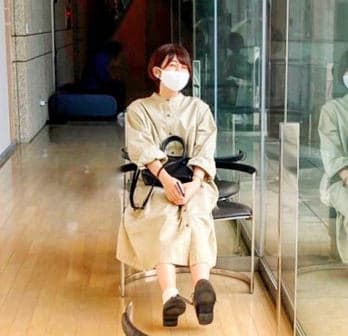*
“‘Otemo-yan is a folk song representative of Kumamoto Prefecture. It’s thought to be the work of Ine Nagata, born in 1865, but we don’t know who the model for the girl who appears in the song, Otemo-yan, was. Known for its light double-time tune and cheerful lyrics, it portrays young women’s perspective on romance and marriage.’”
“Hummm.”
“Hummm? C’mon.”
Looking up at the Otemo-yan statue near the Shinkansen exit at Kumamoto Station, Sumi read the info she’d searched up on her phone. The statue of Otemo-yan in her kimono with not only both hands but even one foot merrily raised was so dynamic she seemed likely to start moving at any moment.
“I guess before Kumamon, she was the most famous character from Kumamoto.”
“What! Really? I had no idea.”
The memorable black bear with the red cheecks plastered all over the station could be found anywhere around town. Souvenir shops were overflowing with Kumamon merch and tourism spots all had Kumamon signboards.
“But why did you suddenly up and say, ‘Let’s join the Otemo-yan Open Dance!’?”
“I mean, Sumi. We’re high-school girls in the bloom of youth with no summer vacation plans, right?”
“Whadaya mean, ‘right’?”
“For Hinokuni Matsuri, I usually only go to the ennichi market at Hanabatake Hiroba, but once when I was little, I saw the open dance. All the dancing ladies were so pretty...”
“...You just felt pressured when you heard Mugi had plans. Like, ‘Oh I gotta do something meaningful, too!’ And the first thing you saw was that poster, right?”
“Urgh.”
“You’re so easy to read.” Her tone was put off, but she laughed gently, “Ah-ha-ha.” We’d been friends for so long that she knew me well.
“Th-that’s not all, though. I mean, we have entrance exams next year, you know. We’ll have to study and whatnot—we won’t be able to just have fun like this year. And once we graduate, we’ll be split up...”
It had been me and Sumi ever since kindergarten. I was having trouble deciding what I wanted to do in the future, but Sumi had her heart set on getting into a university in Kansai.
“...I see. So you want to make memories,” Sumi said quietly. A few people passed by us pulling suitcases. Someday Sumi would pass through here and leave this place.
“Okay, I understand. Let’s do it, then.”
Her words came after a beat, and I jerked my head up. “Really?!”
“Yeah! Besides...I’m glad. That I get to do something with you.”
“S-Sumiii...!”
Seeing her awkward smile, I felt a warmth grow in my chest. “All right!” I shouted. “If we’re gonna do it, we might as well aim to be the best!”
“Ah-ha-ha. Okay, let’s do it!”
“Whoo!” We punched the air. A few people around us looked over at us perplexed, like, What? What’s going on?
Two high-school girls raising our fists next to the Otemo-yan statue. It was such a goofy scene that I laughed even though I was in it.
We had two weeks to go until the festival.
The next day we began our hyper-intense training.
There are two songs used for the open dance. One is the normal “Otemo-yan.” The other is... “Listening to it again...Samba Otemo-yan is really peppy, huh?”
Yes. The other is “Samba Otemo-yan.” The orthodox version is also pretty peppy, but this is on a different level. The whistling and trilling of instruments with an exotic air. Whose idea was it to arrange Otemo-yan as a samba?
For our practice space we chose an empty classroom in a far corner of the school building where no one would find us. The place was littered with old desks and chairs that weren’t being used anymore. On top of being incredibly dusty, there was no a/c, so it was unbearably hot and humid, but beggars can’t be choosers. Once we tied the threadbare curtains aside, opened the windows, and heave-ho’d all the desks and chairs to the back of the room, we sat down on the cool tile floor without caring if our skirts got dirty. Outside, the cicadas were whining so loud it was obnoxious.
“Uhh, so first you clap four times. Then you make fists in front of your chest and go forward. On the fourth step, you raise your left leg. Then both you raise both hands... Oh, this is the pose the statue at the station is doing!”
Referring to a tutorial video someone had uploaded, Sumi stood up and started dancing along. And she ended up standing just like the bronze statue we had seen the day before. Aha, so the statue was doing this choreography.
“After doing that four times, you raise both hands overhead and wave them back and forth six times... Huh, this is pretty easy. Come dance with me, Himawari!”
“All right!”
One, two, three, four.
Two, two, three, four.
Three, two, three, four.
Four, two, three, four.
We set her phone on the floor and danced in circles around it—with stiff steps, tmp-tmp-tmp.
“Clap twice, step at a diagonal with your right foot, then spread your fingers and frame your face with your hands... Take them back, then your left foot goes forward, frame your face again... And then you go back to the beginning... Himawari, you have your hands and feet backwards, no?”
“What?! Oh, I see.”
I could hear someone kicking a soccer ball outside. Someone must have scored. “Nice shot!” someone’s cheer echoed. The band kids’ music ringing throughout the building left me just as speechless as the day before, and the track and field team was chanting “You-can-do-it!” as they ran.
And our little classroom was filled with the music for the Otemo-yan dance, loud enough not to be drowned out by the other voices and sounds.
♪ Kawabatamachi tsan kyā meguro
Kasuga boubura dontacha
Shiri hippyate
Hanazakari hanazakari
Piichiku pāchiku hibari no ko
Genbaku nasubi no igaiga don
[But hey, let’s go around to Kawabatamachi. / The kabocha-faced guys / chase me / I’m in peak bloom / I’m not into boys who twitter like lark chicks / or eggplant-faced guys who are rough like chestnut burrs]
“What’s all the noise in here, you guys?”
We got surprisingly into it and had the music playing so loud that never in a million years would we have considered that someone might be watching us. Poking his head in through the door in the back of the classroom was the guidance counselor Mr. Okazaki. He must have been patrolling the building.
Standing on one foot with both of my hands way up over my head, I must have looked pretty crazy, but I did everything I could to keep my face straight as I answered. “J-just the silly things high-school girls do when they have too much time on their hands.”
“...Hmm. Well, don’t stay too late.”
“...We won’t.”
After looking straight at me with a pitying look in his eyes and saying, “Sorry to bother you,” he shut the door and left. The merry festival music was playing as loud as ever but somehow kind of pointless. After a little while, I heard the “pft” of someone cracking up.
“Pff...hoo-hoo, hoo-hoo-hoo, ah-ha-ha-ha-ha!”
“Sumi, what the heck! How could you stop without me?! That was so embarrassing! Did you see that? The sad look he gave me!”
“Ah-ha-ha-ha! S-sorry, sorry. Hoo-hoo... But Himawari, your excuse was so awkward... Ah-ha-ha!”
“It’s not funny!”
We stopped the music and made a racket joking around. That disorganized way was how our practice session for the day ended.
But the next day, and the next day, and even once summer vacation started, we kept practicing. Just having something to do made me happy somehow.
“Samba Otemo-yan has pretty flashy moves,” said Sumi with a serious expression as she stepped into the classroom we’d gotten permission to use over summer break. She started dancing with the same no-nonsense look on her face. Shaking her hips and shoulders, cheerfully waving her hands...
“Pf-ff-ft. Hey Sumi, could you not dance with such a serious look on your face?”
“...”
“Ah-ha-ha-ha! C’mon, cut it out!”
With her big black glasses and the utterly sober appearance, Sumi danced in earnest, creeping toward me. Ugh. It was too funny. I was sure she was doing it on purpose.
“Hey, Himawari. Quit laughing and practice!”
“Okay, okay.”
One, two, three, four, five, six, seven, eight.
Two, two, three, four, five, six, seven, eight.
Each time our indoor shoes with the yellow rubber trim (our grade’s color) struck the floor, there was an audible, dry sound—tmp-tmp-tmp.
We had memorized the choreography, but if we wanted to win a prize, we would probably need something special to capture people’s attention. We could make an eye-catching transformation like the women in kimono I saw when I was a kid, or...
...is what I was thinking as we danced lightly around when the door to the classroom opened again.
My eyes popped wide in surprise, and I saw it was Mr. Okazaki in his track jacket standing there. I braced myself instinctively, thinking we would get scolded, but apparently that wasn’t the case. On the contrary, he held out cans of soda.
“Just wanted to bring you this. It’s hot out, so make sure you drink enough.”
“Huh? ...Th-thank you!”
Sumi and I bobbed our heads and took the soda. The ice-cold can felt good in my hand. It was lemon cider from the vending machine on the first floor, so we both cracked a smile. What’s there to hide? We loved this soda. We would often split a can after gym class.
“Umm, but why...?” Sumi asked timidly.
Mr. Okazaki seemed a bit embarrassed as he said, “Well...you’re going to go to the Otemo-yan Open Dance, right? Back in college, I did it with some friends from the track team...not that that’s a reason. I just felt nostalgic. Don’t tell the other kids.”
Mr. Okazaki, always cranky and chewing students out... I always thought I kinda couldn’t stand him, but hearing this made me feel a bit closer to him. Sumi must have felt the same way. Going with the flow of the mood, I decided to ask him a question. “Um, Mr. Okazaki?”
“What?”
“What does this Otemo-yan song mean, anyhow? We looked it up online, but I still don’t really get it.”
“Yeah, it’s really old... I actually don’t know what it means, either.”
“Oh, really? Even though you danced?”
“Honestly, it was kind of a joke at first...a bunch of friends putting in an application. But once we started rehearsing between classes and track practice, it turned out to be pretty fun. Now we’re all grown up, and everyone has embarked on their own lives, but whenever we get together Otemo-yan is definitely one of the things we talk about. It’s a good memory.”
“Huh...”
“If you’re curious about the meaning, you should do more research. Oh, why not write a report and submit it to the prefecture’s Independent Research Contest? I’m pretty sure the deadline isn’t until the end of August.”
“Whoa, never mind, never mind. We’re fine!”
There was no way I was going to voluntarily go write a paper. When I rushed to interrupt, he flashed his white teeth in a grin and said, “Well, good luck!” and then headed off to supervise basketball practice.
After he left Sumi and I were quiet for a little while. We had always been like that—a similar sense of timing for when we wanted to chat and when we wanted to stay silent.
“Wanna practice some more?”
It was Sumi who spoke up first, and I responded with a quick, “Sure,” and tapped play on the practice video.
Three days before the open dance, I was walking with Sumi near Kumamoto Castle after shopping on one of the arcade streets when we saw a familiar face. Before we could even say, “Oh!” she recognized us and walked over looking truly happy to see us.
“Hima, Sumi!”
“Mugi, what are you up to?”
Mugi was dressed in a boyish look—oversized T-shirt, shorts, and chunky sneakers—and had a camera hanging around her neck.
“I was just taking some pictures. Look, here’s Kumamoto Castle. Nice shot, right?”
The photo showed the castle, which was getting some reconstruction done. The big and small towers, the stone wall rising up to protect them, and the Sakura trees that bloom so prettily in spring were all tinted the deep red of sunset—it felt like a fantasy. There was some construction machinery in the picture, too, but the backlight made them such a dark red they just seemed like part of the castle; the castle was huge to begin with but they made it look even bigger.
“Wow, gorgeous! Are you going to put this on Insta, too?”
“Yeah!”
Mugi answered Sumi’s question with a happy smile. Her expression was filled with confidence and hope. I felt sort of restless as I said, “U-uh, so,” speaking up for the first time in the conversation. Hearing how pathetic my shaking voice sounded was kind of funny. “Mugi, are you going to be a photographer?”
“Huh? Yeah, if I can, I’d like to. Ah-ha-ha. It’s sort of embarrassing to admit.”
“Oh...that’s awesome. So then the rumor that you’ll go to Tokyo after graduation is true, huh.”
“Huh? Where’d you get that idea?”
“Huh?”
“I’m not going to Tokyo! Ugh, who said that?” Mugi sounded genuinely flustered.
My jaw dropped in spite of myself.
“I love Kumamoto. I mean, I dunno if I’ll stay forever, but I plan to be here for a while. I take pictures and post them online because I want wayyyy more people to know how great this city is.”
Her words were so honest. I was so overwhelmed I had no words. When I glanced at Sumi, her face was frozen in surprise.
“My grandma lives out in Takamori. I used to go out to visit her all the time on the Minami-Aso Railway. It’s like heaven in the spring when the canola is blooming, and the sheer cliffs and the forest you could see from the overpass were so beautiful you’d get the shivers. I really loved that view...but the overpass collapsed in the earthquake and the train doesn’t run anymore. It was a huge shock,” said Mugi. “So now when we go to visit Grandma, we go in the car...and one time I got to thinking. If this was going to happen, then I wish I had captured a lot more of the beautiful scenery in photographs. Then another time, I thought, Wait...it’s not too late! I can start now!” She laughed a bright “ah-ha-ha.”
I felt a kind of ache in my chest and could only manage, “I see,” in reply.
I had been watching her with envy, all insecure in my head, but maybe that was stupid. Yeah. When I figured that out, I felt a bit better.
“Are you guys going to Hinokuni Matsuri?”
Josaien and Hanabatake Hiroba, near the castle, were being prepped bit by bit for the ennichi market. Mugi glanced over as she brought it up.
“Yeah, that’s the plan.”
“Oh! I’m going too, so I hope we run into each other.” Then she said, “Oh, shoot. I’m supposed to be meeting my mom at Kumamoto Station,” before giving us a big wave and blowing out of there like a storm passing. “See ya!”
“Mugi really is awesome.” Sumi murmured, watching her slender figure go.
This time I could say, “Yeah, she really is.” And I meant it.
That night, I searched for Mugi’s Instagram account and looked at all her pictures.
People beaming as they waved from the Minami-Aso Railway’s trolley. The green of the plants growing thickly in Tsukimawari Park and a goat with a carefree look on its face munching on some grass. The “Ganbaru bai Kumamoto” banner of encouragement hanging at Aso Shrine and the nearby Ichinomiya-monzenmachi shopping street—it must have been around May because there were carp streamers swimming in the clear sky. A row of street lamps glowing hazy orange at night in Kurokawa Onsen; the five bridges of Amakusa reaching slender over the sparkling sea...
As I gazed at all of the lovely scenes of Kumamoto Mugi had captured, I gradually got sleepy, and at some point, I let consciousness slip away.





